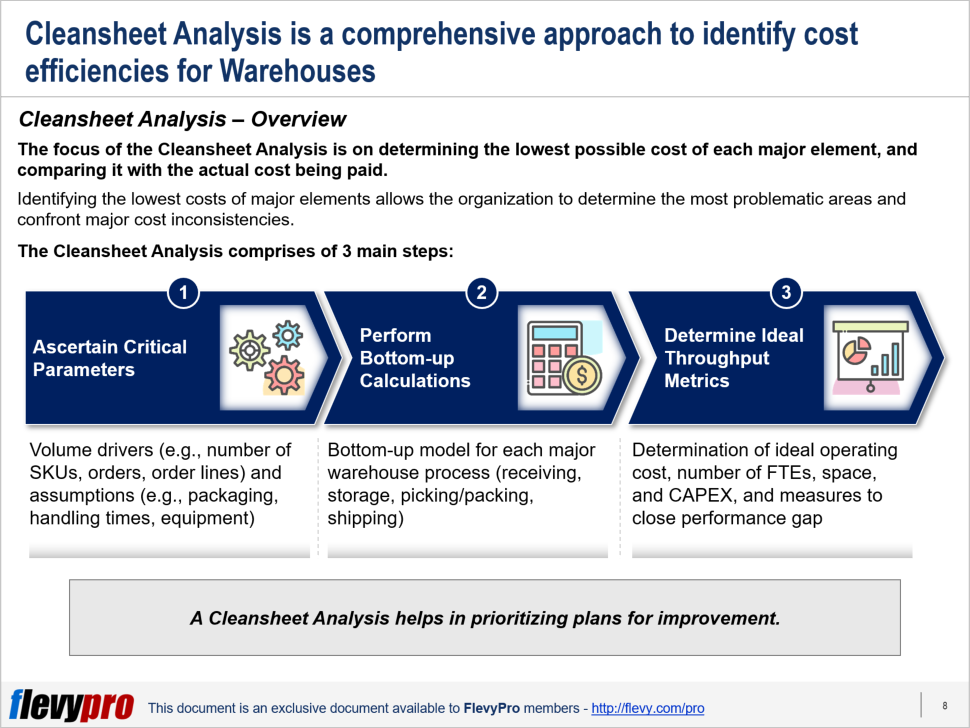Warehousing costs at most firms are extraordinarily higher than they ought to be. Across the world, organizations spend around €300 billion annually on Warehouse Management. With the boom in online retail stores and the increasing complexity of Supply Chain Management, this spending is going to surge further.
The leadership at these organizations understands that they should spend less on Warehousing operations, but is not aware of the real costs associated with it. Most leaders are unable to tell how much is their human resources cost per facility.
Lack of appreciation of true Warehousing operations costs is one of the main reasons for failure of most Business Transformation programs. Without this knowledge, the leadership is unable to comprehend where the improvement areas lie and how much value creation can be achieved from those.
Ascertaining these costs warrants a clear approach, which many organizations lack. Most firms inquire about their operational costs from 3rd party Logistics (3PL) providers—by soliciting requests for quotations (RFQs). However, this does not give an idea of what these principal activities really cost. The most common approaches to Warehouse costing include:
- Benchmarking
- Cleansheet Analysis
Benchmarking
The Benchmarking method uses a top-down approach to analyze costs based on industry benchmarks. However, accessibility of benchmarks at lower levels is hard to access, since benchmarks available for comparison are predominantly at high levels—e.g., Total Warehouse Cost as a proportion of Cost of Goods Sold. Industry Benchmarking fails to take into consideration distinct product or service offerings.
Cleansheet Analysis
Cleansheet (or a Bottom-up Analysis) is a more comprehensive method to estimate Warehousing costs. It is a numerical approach to ascertain precise costs of critical components of Warehousing operations, including facility spread out, workforce, and equipment. This method facilitates in understanding where the cost exceeds and how it can be eliminated.
The focus of the Cleansheet Analysis is on determining the lowest possible cost of each major element, and comparing it with the actual cost being paid. Identifying the lowest costs of major elements allows the organization to determine the most problematic areas and confront major cost inconsistencies.
The Cleansheet Analysis comprises of 3 main steps:
- Ascertain Critical Parameters
- Perform Bottom-up Calculations
- Determine Ideal Throughput Metrics
Let’s dig a bit deeper into the initial step.
Ascertain Critical Parameters
The first step of the Cleansheet Analysis entails scoping the Warehousing facility’s configuration, work, team, volumes, and orders. Specifically, this includes evaluating:
- The workforce, accountability distribution, workloads.
- The actual warehouse activity levels.
- The volumes.
- The volume drivers—number of SKUs, order patterns, order lines.
Interested in learning more about the steps to using a Cleansheet Analysis? You can download an editable PowerPoint presentation on Warehouse Costing: Cleansheet Analysis here on the Flevy documents marketplace.
Do You Find Value in This Framework?
You can download in-depth presentations on this and hundreds of similar business frameworks from the FlevyPro Library. FlevyPro is trusted and utilized by 1000s of management consultants and corporate executives. Here’s what some have to say:
“My FlevyPro subscription provides me with the most popular frameworks and decks in demand in today’s market. They not only augment my existing consulting and coaching offerings and delivery, but also keep me abreast of the latest trends, inspire new products and service offerings for my practice, and educate me in a fraction of the time and money of other solutions. I strongly recommend FlevyPro to any consultant serious about success.”
– Bill Branson, Founder at Strategic Business Architects
“As a niche strategic consulting firm, Flevy and FlevyPro frameworks and documents are an on-going reference to help us structure our findings and recommendations to our clients as well as improve their clarity, strength, and visual power. For us, it is an invaluable resource to increase our impact and value.”
– David Coloma, Consulting Area Manager at Cynertia Consulting
“As a small business owner, the resource material available from FlevyPro has proven to be invaluable. The ability to search for material on demand based our project events and client requirements was great for me and proved very beneficial to my clients. Importantly, being able to easily edit and tailor the material for specific purposes helped us to make presentations, knowledge sharing, and toolkit development, which formed part of the overall program collateral. While FlevyPro contains resource material that any consultancy, project or delivery firm must have, it is an essential part of a small firm or independent consultant’s toolbox.”
– Michael Duff, Managing Director at Change Strategy (UK)

Comments